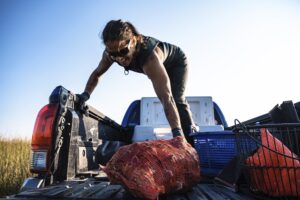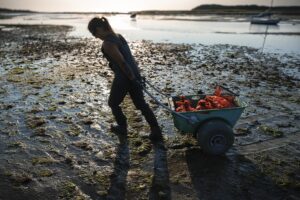WELLFLEET — At select board meetings throughout the summer, wild oyster harvesters used the public comment period as a platform to decry the state of the town’s wild fishery.

“I am extremely concerned with the wild fishery. There are no oysters out there,” said Lisa Dexter at the June 4 select board meeting. “Unless we do something about it and manage it differently, it is not going to recover.”
Timothy Hughes said much the same thing during his interview as a candidate for the shellfish advisory board on July 16. He told the select board that the wild fishery was “pretty disarrayed,” and his “livelihood is threatened.”
Despite these worries, several other wild pickers, shellfish wholesalers, and Shellfish Constable Nancy Civetta all painted a different picture in describing the fishery.
Civetta presented catch data from 2022 and 2023 to the select board on Aug. 20 and to the shellfish advisory board on Sept. 9. The data show stock holding steady from 2022 to 2023 and a 4-percent increase in the number of oyster bushels harvested in that period.
Wild harvesters, in contrast to aquaculture grant holders who farm on leased town land in the harbor, rely on finding naturally occurring oysters growing in other public areas. According to Civetta, the town sold 91 commercial shellfishing licenses this year to people who fish only in the wild; another 136 went to grant holders.
Changes in market demand may be what’s affecting wild pickers’ experience, Civetta told the select board. In the years following the pandemic, as restaurants reopened their doors, “the markets were taking every oyster they could get,” she said. The boom in demand was easily met by a supply that was bountiful because the harvest had been low during the pandemic.
Civetta also reported a 28-percent jump in the number of wild harvesters working the flats in 2023. “Even with the large increase in shellfishing effort, we still had an uptick in the number of bushels harvested, which illustrates that the oyster resource was available and plentiful,” she said.
While this summer has not been as fruitful, the harvest has not dipped below pre-pandemic levels, Civetta said. “It could certainly feel like the shellfishery is underperforming” after a spike in supply, Civetta said, but “we are heading back into normal oyster market territory and oyster conditions following such strong years.”
Wholesaler Alex Hay, president of Wellfleet Shellfish Company, said that he has seen a “pretty steady” supply of wild oysters this summer.
Sonya Woodman, who has been wild harvesting since 2018, said she has been able to meet her limit every day this summer. “It isn’t that there isn’t a population,” she said. “With wild fisheries, the population is always shifting.”

Wild harvesters are allowed to fill one bushel, or about 500 oysters, per harvesting area. Those areas include Chipman’s Cove, Duck Creek, Herring River, and Egg Island, as well as other nooks in the harbor. Regulations cap the total number of bushels harvested in different areas at five per day. Woodman said that the state of the wild fishery “is difficult to get straight information on. You get some people who say it’s great, and some people who say it’s terrible.”
One reason why opinions vary, Woodman said, is that the supply varies depending on location in the harbor. For example, pickers at Chipman’s Cove, which is open to both commercial and recreational harvesters from October to April, may have found a dearth of oysters there. “A lot of people use it as a gauge for the entire fishery,” Woodman said. “It isn’t the entire fishery.”
At the shellfish advisory board’s Sept. 9 meeting, Dexter blamed her experience finding fewer wild oysters on recreational harvests during the summer that she thinks are “too much for the resource to handle. I can’t even get 100 oysters.”
Civetta replied that Indian Neck is the only area of Wellfleet Harbor open to recreational shellfishing during the summer, and that recreational harvesters can pick only on Wednesdays and Sundays.
The select board voted at the end of 2022 to require grant holders to purchase commercial shellfish permits in addition to leasing their grants. Commercial permits were previously required only for harvesting in the wild. The change, some wild harvesters think, may have encouraged grant holders to go after oysters in the wild in addition to farming on their grants.
“People who might not normally go out into the wild were going out to pick,” Woodman said. “I think that did cause a little bit of strain in certain spots.”
But Civetta didn’t think that change amounted to much. The shellfish dept., she said, “has not noticed many grant holders seriously using their commercial permits.”
The number of oysters in the wild always ebbs and flows, Civetta said. Wild oysters can take two to three years to mature to three-inch legal size, so some years there may be more adult oysters than others.
“The wild oyster resource is always going to be cyclical,” Civetta told the select board. “We are always at the whim of Mother Nature.” But, she added, “After such a sustained and heavy harvest effort for over two years, many wild oysters were removed from our estuaries.”



